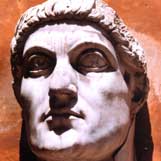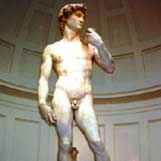History of Italy


Italian History 101
Ancient
Rome
The
political history of ancient Rome is marked by three periods of about 500 years
duration. In the first period (from 753-509 BC) the city developed from a village to
a city ruled by kings. The second period (from 509-27 BC) was when the Romans expelled the kings and established the
Roman Republic which had two annually elected
consuls as its head, and was guided by the Senate. The third period (from 27 BC-476
AD) was when Rome fell under the domination of emperors beginning with Julius Caesar. During this period, Rome was known for its
great public works and strongly centralized government.
Modern
motion pictures and television often portray ancient Romans as military
conquerors and pleasure seekers. There is some truth to both these
images. Rome's armies brutally subdued the Mediterranean world and Romans enjoyed lavish,
sometimes cruel entertainment spectacles -
gladiatorial combats, chariot races, and animal hunts in the arena. Yet these
same Romans created a civilization that has shaped our world history for 2,000
years. The founders of the American government looked to the Roman Republic as
a
model.
The
Legend of the Founding of Rome
Rome
was founded in 753 BC by Romulus and his twin brother Remus. They were
grandsons of a king who was deposed by his brother. The new king tried to
kill the baby twins by having them thrown into the Tiber River, but the infants
washed ashore and were suckled by a she-wolf (the symbol of Rome). When
the brothers grew up, they restored their father to his throne, and then founded
a new city on the Palatine Hill above the river. Romulus erected a wall
around the site of the new city, and when Remus tried to assert his leadership
by scornfully leaping over the inadequate wall, Romulus killed him becoming
the city's first king, and giving the city its name (Rome from Romulus).
Ancient Rome is referred to as the “City of Seven Hills” because it was
built on seven hills surrounded by a line of fortifications.
The
Fall of Rome
Rome
flourished for five centuries (from 27 BC-476 AD) under the rule of Emperors who
subjugated the whole Western world. As the years
passed, the Empire was divided into eastern and western portions and these
divisions created internal weaknesses that lead to Rome's demise. Two main events
lead to the Fall of Rome: plundering of the city of
Rome by an invading tribe, the Vandals, and the abdication of the last Roman
emperor, Romulus Augustus (476). The Fall of the Roman
Empire marked the start of the Middle Ages.
The
Renaissance
The
Renaissance or “rebirth” occurred from the fourteenth through the middle of
the seventeenth centuries. The basis for this period was a rediscovery of
the literature and art of Ancient Greece and Rome. One of the major figures of
this period was Leonardo da Vinci, an Italian artist, scientist and
inventor in the late fifteenth and early sixteenth centuries. His drawings
include studies of the human body, natural objects, and invention ideas. He is most famous for his
paintings the Mona Lisa and The Last Supper. Michelangelo, an Italian
sculptor, painter, and architect lived around the same time. He sculpted the
David, painted the ceiling and rear wall of the Sistine Chapel, and served as one
of the architects of Saint Peter’s Basilica, designing its famous dome.
He is considered one of the greatest artists of all time.
Modern
Italy
Italy
as we know it unified as a state in 1870. Its largest city, Rome, was made
the capital in 1871. Between 1870 and World War I, many Italians emigrated
to the United States and Argentina. Discontent and economic depression
helped Benito Mussolini rise to power in 1922. Italy then entered a
military alliance with Germany and Japan, becoming known as the Axis Powers of
World War II. In 1943 Italians turned against Mussolini and continued in
the war on the Allied side while still suffering from German occupation.
Italy has been a member of NATO since 1949.
Unemployment
is an ongoing problem in Italy and even the most educated work for free for
years just to get a foot on the employment ladder. Corruption has also
been a major problem in Italy. A series of scandals and Mafia trials in
the 1990s led to a major governmental house cleaning. Italy is now a
part of the European Union. Today Rome, known as the “Eternal City,”
is considered one of the world’s greatest centers of history, art,
architecture and religion.
Ancient
Religious Practices
The earliest Romans were primarily an agricultural people and focused their religion on spirits who presided over the natural world (springs, forests, rivers, etc.). Some of these deities survived over time to become the gods honored with small shrines at crossroads throughout Italy. Early superstitions, such as the magical power of the evil eye, also continued long after the Romans introduced new religious practices. To these primitive beliefs the Romans added such Etruscan practices as interpreting the will of the gods by the flight of birds (auspices) or by the study of an animal's liver. The Etruscans had also adopted gods from the Greek pantheon, and many of these divinities were passed on to the Romans. Zeus, the Greek god of the skies, had a counterpart in the Roman god Jupiter, while Hera, the wife of Zeus and queen of the gods, became the Roman goddess Juno. Other Greek gods with Roman equivalents included Aphrodite, the goddess of love, known to the Romans as Venus, and the Greek god of war, Ares, who was called Mars by the Romans.
The Romans expected their gods to respond to offerings. The Latin
phrase quid pro quo (one thing for another) which described such an exchange is
still used today. Gradually, groups of priests and priestesses took
responsibility for the worship of specific gods and goddesses. The most notable
of these groups were vestal virgins who served Vesta, the goddess of the
hearth.
The
Calendar
The
Roman calendar was basically a religious document. Some months were named
after gods, including January for Janus, who presided over beginnings, and March
for Mars, the war god. Other months were merely numbered. The Roman calendar
originally began with March, so the seventh month, September, took its name from
the Latin word septem for seven. The name of the eighth month, or October,
derived from octo for eight, and others followed suit. The Romans
also named the days of the week for gods. The Romance languages continue to use
these, while in English the names of their ancient Germanic
counterparts are used. Hence Friday, the day of the goddess of love, Venus, is
vendredi in French, but takes its English name from Freia, the German goddess of
love. In 45 BC when Julius Caesar acted as the dictator of Rome, he
revised the calendar to reflect the solar year, making it 365 days
long and adding an extra day every fourth year, or leap year.
Architecture
and Public Works
Roman
originality appears most often in engineering and construction. Appius Claudius
Caecus commissioned work on the paved military road south from Rome in about 300
BC, which became known as the Appian Way. He also initiated construction of
Rome's first aqueduct to bring water to the city from nearby hills. These
projects later became models for hundreds of miles of aqueducts and
thousands of miles of paved highway built throughout Rome's empire. Romans
took the arch from the Etruscans, but pioneered the use of concrete covered by
brick as the basis for most monumental buildings, including baths,
amphitheaters, aqueducts, and markets. In the 2nd century BC the Romans
devised their own characteristic public buildings called basilicas - large covered
spaces for politics, law, and commerce. Much later in the 4th century AD,
the early Christians adopted the same type of structure for churches.
Famous
Sayings
-
“All roads lead to Rome” is a proverb that means all paths or activities lead to the center of things. This was literally true in the days of the Roman Empire when all of the roads radiated out from the city of Rome.
-
“Fiddle while Rome burns” refers to someone doing something trivial or irresponsible during an emergency. The legend is that while the city of Rome was being destroyed by a fire, the emperor Nero played his violin. This revealed his lack of concern for the people of his empire.
-
“I came, I saw, I conquered.” (Vini, vidi, vinci) is a quote from Julius Caesar as he reported to the Senate on his campaign in Asia.
-
“Rome wasn’t built in a day” implies that valuable projects take time.
-
The destructiveness of the Vandals is where we got the word vandalism.
Travels with Friends: Learn more about other European destinations and tips for traveling within Europe. www.TravelsWithFriends.com
Private Guides:
See Europe and learn about its history
with your own private guide.
www.PrivateGuidesInEurope.com

Europe travel news sent to you 15 times a year.
Top sights, hotel reviews, travel tips and more.
Private Tours in France, Greece, Italy and Spain.
Join one of our small group Europe tours.
Tours and day trips to help you explore Europe.
Hire a professional from Private Guides in Europe.
Let us help personalize your European itinerary.
Our thoughts on how to best travel in Europe.
For more information or to send us an email.
Car Rentals, Flights, Hotels, Rail Passes
